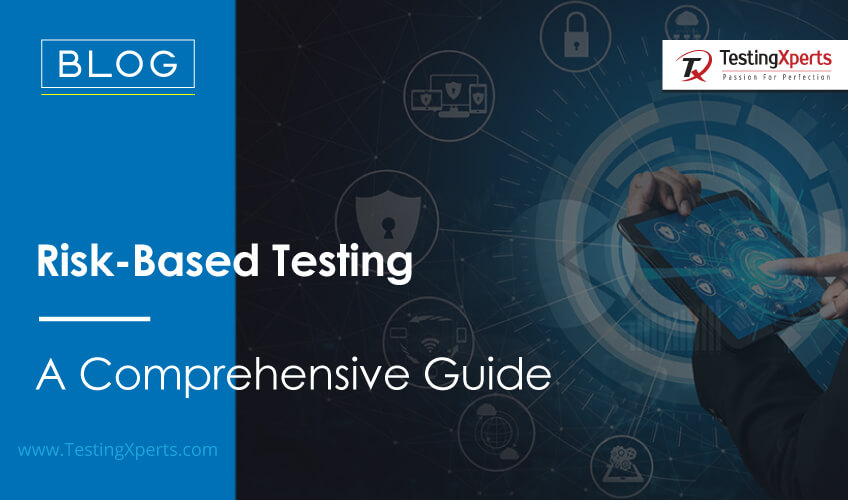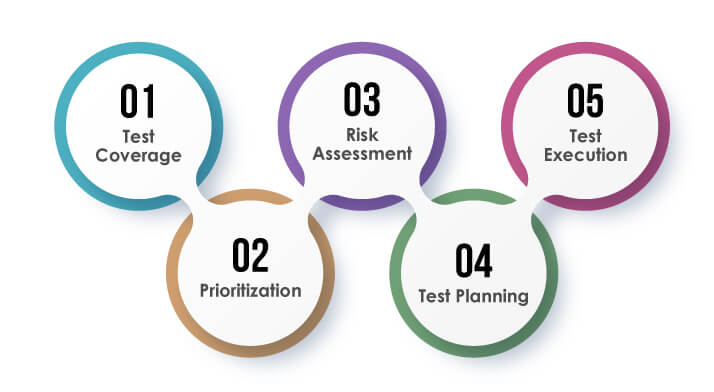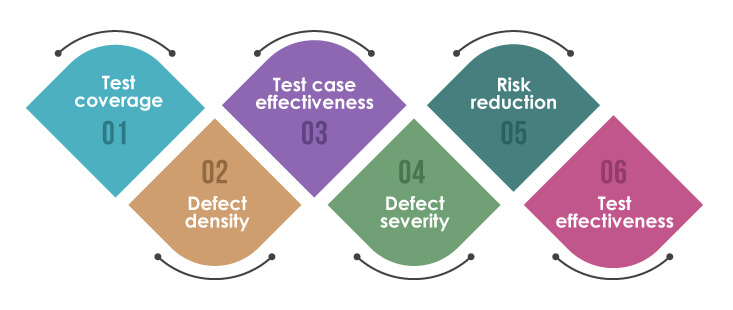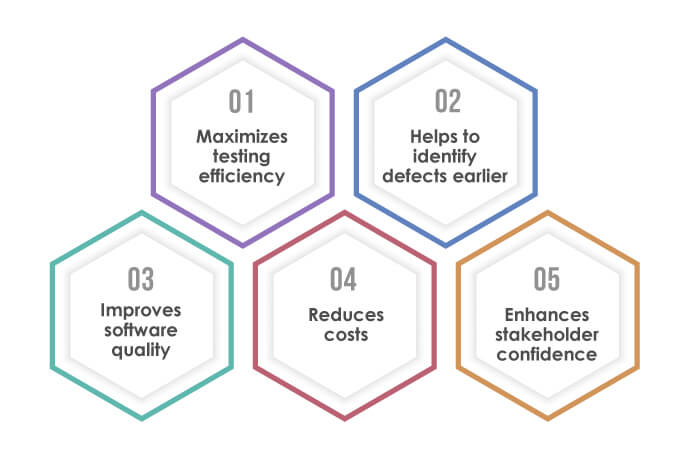Recommended Blogs
Risk-Based Testing – A Comprehensive Guide
By Manjeet Kumar - Read time: 4 minutes

Table of Contents
-
- What is Risk-Based Testing
- How Risk-Based Testing Differs from Other Testing Approaches?
- What metrics are used in Risk-Based Testing reports?
- How to Prepare a Test Report
- How risk risk-based breakdown structure work
- Steps in a Risk-Based Testing Approach
- Tools and Automation for Risk-Based Testing
- Benefits of Risk-Based Testing for Businesses in the UK
- Leverage AI for Smarter Risk Assessment
- Conclusion
- How can TestingXperts help Businesses with Risk-Based Testing?
Risk-based testing is a software testing approach that prioritises testing efforts and resources based on different software application components’ potential risks and impacts. The goal of risk-based quality assurance testing is to identify the critical areas of the software that require the most attention and to allocate testing resources accordingly.
The process of risk-based testing involves analysing the software application to identify potential risks. For instance, defects, failures, security breaches, or other types of issues that could negatively impact the end users or the business. Once risks are identified, they are evaluated based on their likelihood of occurring and their potential impact on the system.
Based on this analysis, testing efforts for businesses in the United Kingdom should be focused on the areas with the highest risk. Critical functionalities and features are tested more thoroughly than less important or lower-risk features. This approach allows testing teams to prioritise their efforts to focus on the areas that are most likely to cause problems or issues.
What is Risk-Based Testing
The primary goal of risk-based testing is to identify and mitigate the most significant risks that could affect the quality, reliability, or usability of the software. By focused testing efforts on the areas that are most likely to pose risks, risk-based testing can help ensure that the software meets the requirements and expectations of stakeholders and reduces the likelihood of defects or issues that could impact the user experience or the business value of the application.
The key outcome of risk-based testing is to ensure that software is of high quality and meets the needs and expectations of stakeholders by identifying and mitigating the most significant risks that could impact the success of the application.
How Risk-Based Testing Differs from other Testing Approaches?
Risk-based testing focuses on identifying and prioritizing testing activities based on the level of risk associated with various features or components of the software system under test. Here are some ways in which risk-based testing differs from other testing approaches:

Test coverage:
The focus is on identifying the most critical areas of the software system that require the most attention and coverage, while other testing approaches may aim for a broader range across the system.
Prioritization:
It prioritizes testing activities based on the level of risk associated with the various features or components of the software system, while other testing approaches may prioritize based on functional requirements or other factors.
Risk assessment:
The risk assessment is an ongoing process that helps identify, assess and mitigate risks throughout the software development lifecycle. At the same time, other testing approaches may not emphasize risk assessment as much.
Test planning:
Careful planning is needed to identify critical areas and prioritize testing based on associated risks. Other testing approaches may not require such detailed planning.
Test execution:
It focuses on executing tests in areas of the system identified as high-risk, while other testing approaches may run tests based on functional requirements or other criteria.
Risk-Based Testing aims to optimize the testing effort by focusing on areas of the software system that pose the highest risks to quality and functionality. This approach helps ensure that testing efforts are aligned with business objectives and can help reduce the overall testing effort by focusing on areas that are most critical.
What metrics are used in Risk-Based Testing reports?

The main objective of risk-based testing is to identify and mitigate the high-risk areas in the application. The following are some of the results and metrics that can be used to evaluate the effectiveness of risk-based testing:
Test coverage:
Test coverage is the extent to which the software under test has been tested. In risk-based software testing, the focus is on high-risk areas, so the test coverage should reflect this. A higher percentage of test coverage in high-risk areas indicates that the testing effort has been targeted effectively.
Defect density:
Defect density is the number of defects found in a specific area of the software. In risk-based testing, high-risk areas should have a higher defect density. Low defect density in high-risk areas may suggest insufficient testing focus on those critical components.
Test case effectiveness:
Test case effectiveness measures how well the test cases cover the requirements and identify defects. In risk-based approach to testing, test case effectiveness should be high for high-risk areas.
Defect severity:
Defect severity measures the impact of a defect on the software. In risk-based testing approach, high-risk areas should have a higher severity level for defects found.
Risk reduction:
Risk reduction measures the effectiveness of the risk-based testing approach. It compares the number of high-risk areas before testing to the number of high-risk areas after testing. The higher the risk reduction, the more effective the testing approach.
Test effectiveness:
Test effectiveness measures the overall effectiveness of the testing effort. In risk-based testing, the test effectiveness should be high for high-risk areas.
How to Prepare a Test Report

Preparing a test report involves documenting the results and findings of a testing process. The report should be detailed, organized, and concise, and it should communicate the information effectively to stakeholders such as project managers, developers, and clients.
Here are some steps to follow when preparing a test report:
Identify the purpose and audience of the report:
Before starting the report, identify the intended purpose and audience. Determine what information needs to be included, and how the report will be used.
Define the scope of the testing:
Specify the scope of the testing that was performed, including the type of testing (risk-based functional testing, risk-based regression testing, risk-based performance testing, risk-based security testing), the testing environment, and the systems or applications that were tested.
Describe the testing process:
Describe the testing process that was used, including the testing methodology, test plan, and test cases. Include any issues that were encountered during the testing process.
Present the results:
Present the results of the testing in a clear and concise manner. Use tables, charts, and graphs to help visualize the data. Include any defects that were found during testing, along with their severity and priority.
Provide recommendations:
Provide recommendations for addressing the defects that were found during testing. These recommendations include suggested code changes, updates to the test plan, and additional testing that may be required.
Conclude the report:
Conclude the report by summarizing the key findings and recommendations. Include any lessons learned during the testing process and highlight any areas that may require additional attention in future testing efforts.
How risk risk-based breakdown structure work
Risk Breakdown Structure (RBS) is a hierarchical representation of potential project risks organized by categories and subcategories. It is a tool used in project management to identify, analyze and communicate project risks to stakeholders.
The RBS typically includes categories such as external risks (related to market, legal, and regulatory factors), internal risks (related to project management, technology, and resources), and other risks (related to environmental and safety factors). Each category is further subdivided into more specific risks, which are then analyzed in more detail to determine their probability of occurrence, potential impact, and strategies to mitigate or manage them.
Steps in a Risk-Based Testing Approach

A risk-based testing approach is a method of testing software that prioritizes testing efforts based on the level of risk associated with the system under test. The following are the general steps involved in a risk-based testing :
Identify Risks:
The first step in a risk-based testing approach is to identify the potential risks associated with the software. This can be done by reviewing requirements, user stories, and other project documentation, as well as by consulting with subject matter experts.
Assess Risks:
Once the risks are identified, the next step is to assess their likelihood and impact on the software system. This can be done using various techniques such as risk matrices, risk registers, or probability and impact analysis.
Prioritize Risks:
After assessing the risks, the next step is to prioritize them based on their severity, likelihood, and impact. This prioritization helps to determine which risks to address first or later.
Develop Test Cases:
Once the risks are prioritized, the next step is to develop test cases that pay attention to the most critical threats. These test cases should cover the functionality of the software that is most likely to be affected by the identified risks.
Execute Tests:
The test cases developed in the previous step should be executed to verify that the software functions as intended and to identify any defects or issues.
Evaluate Results:
The results of the tests should be evaluated to determine if the software meets the desired level of quality. If any defects or issues are identified, they should be prioritized based on their severity and addressed in subsequent testing cycles.
Repeat:
The risk-based testing approach is an iterative process, and the steps outlined above should be repeated until the desired level of quality is achieved.
Tools and Automation for Risk-Based Testing
Modern risk-based testing is about smart planning and execution. The right tools and automation frameworks scale AI-driven strategies with speed. Some risk-based testing tools include:
- Test Management Suites
Teams may link test cases to risk levels, preserve traceability, and match testing priorities with business effect using platforms like TestRail, Xray, and Zephyr. These tools make communication easier and guarantee that testers concentrate on the most important tasks.
- Risk Matrix Generators
Risk matrix solutions, whether independent or integrated, assist teams in visualizing which elements have the greatest potential for failure and business consequences. These matrices direct data-driven choices on the distribution of effort and the selection of test cases.
- AI-Powered Risk Analytics
AI is used by next-generation platforms to examine test coverage gaps, code churn, and historical defect trends. These solutions allow teams to act proactively before problems arise by automatically indicating high-risk areas.
- Automation Frameworks
Automation is essential to the success of risk-based testing. High-priority tests can be dynamically triggered by continuous testing pipelines according to risk scores, guaranteeing prompt feedback on areas that are crucial to the company following each build.
What are the benefits of Risk-Based Testing for UK businesses?

Risk-based testing is a software testing approach that involves identifying and prioritizing the most critical risks associated with a software application and focusing testing efforts on those areas. Here are some of the key benefits of using risk-based testing service:
Maximizes testing efficiency:
By focusing testing efforts on the most critical areas of the software, risk-based testing ensures that the testing team is using its resources efficiently. This approach allows testers to focus their time and energy on the areas of the application that are most likely to cause problems or have the highest impact on users.
Helps to identify defects earlier:
Risk-based testing enables testers to identify defects and vulnerabilities earlier in the development process. This approach helps prevent costly issues later in development by addressing risks early in the testing process.
Improves software quality:
By focusing testing efforts on the most critical areas of the software, risk-based testing helps to ensure that the application meets the needs and expectations of its users. This approach can lead to higher quality software that is more reliable, efficient, and user-friendly.
Reduces costs:
Risk-based testing can help to reduce the overall costs associated with software testing. By prioritizing the most critical areas of the application, this approach ensures that testing resources are used efficiently and effectively, which can help to reduce the time and costs associated with testing.
Enhances stakeholder confidence:
By prioritizing the most critical areas of the software, risk-based testing can help to build stakeholder confidence in the application. This approach demonstrates a clear focus on quality and can help to build trust among users, customers, and other stakeholders.
Leverage AI for Smarter Risk Assessment
With software systems getting complex, traditional risk assessment methods cannot cope up. Artificial Intelligence plays a crucial role in improving how teams identify and prioritise risk.
AI models can analyse large historical data to detect logs, code changes, test coverage, and commit frequency. These further help flag areas that have a higher failure probability.
It enables QA teams to focus testing efforts on modules that are likely to break before manual risk analysis is performed. For example, if a component has a higher defect recurrence rate or is undergoing frequent code changes, AI can quickly surface it as high risk and prompt deeper testing.
AI-driven risk assessment guarantees accurate prioritisation and supports faster test planning decisions.
Align Risk-Based Testing with Compliance Requirements
Banking, insurance, and healthcare are some of the industries that have to follow tight rules. So, risk-based testing should be in line with compliance by mapping test cases. It makes sure that compliance areas with a lot of risk and impact are never missed.
For example, the GDPR’s requirements for data protection can be perceived as threats. Adding compliance to RBT will make it less likely that you will fail an audit or get a fine.
Conclusion
In conclusion, risk-based testing is an important approach to software testing that helps ensure that testing efforts focus on the most critical areas of the software or system. By prioritizing testing efforts based on potential risks, risk-based testing can help improve the effectiveness and efficiency of the testing process, ultimately leading to higher-quality software and a better user experience.
How can TestingXperts help Businesses in the United Kingdom with Risk-Based Testing?
Tx is one of the Top 5 pure-play software testing services providers globally. Fortune clients have chosen Tx as a trusted QA partner, ensuring superior testing results for its global clientele. We have expertise in end-to-end testing services for international clients across different industry domains like insurance, telecom, healthcare, BFSI, retail & eCommerce, etc.
With over a decade of pure-play testing experience and domain knowledge, Tx has been serving the global clientele with high-quality next-gen testing services to deliver superior solutions to its clients.
FAQs
Risk-based testing (RBT) is a software testing approach that prioritises testing activities based on risk. It identifies high-risk areas where failures would have the most significant impact and thus allocates resources accordingly. This ensures efficient testing by maximising coverage of critical functions while minimising time and cost.
Risk-based testing improves software quality by focusing on high-risk areas and identifying critical defects early. It optimizes testing process, improves test coverage, and reduces the likelihood of failures in production.
Key steps include risk identification, risk assessment, test planning based on risk levels, test execution with priority on high-risk areas, and continuous monitoring to adjust test strategies as needed.
Test cases are prioritized based on risk factors such as business impact, likelihood of failure, regulatory requirements, and system complexity. High-risk functionalities receive more extensive testing, while low-risk areas get minimal testing focus.
Industries with high regulatory and security demands, such as banking, healthcare, insurance, aerospace, and telecommunications, benefit the most from risk-based testing. It ensures compliance, data security, and system reliability in these sectors.
Discover more
Stay Updated
Subscribe for more info


